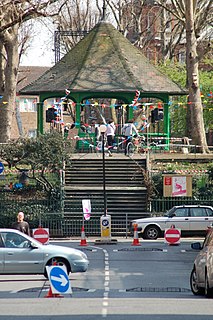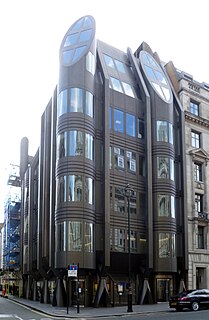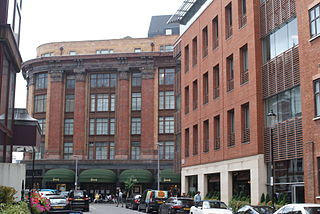Related Research Articles

Vauxhall Bridge is a Grade II* listed steel and granite deck arch bridge in central London. It crosses the River Thames in a southeast–northwest direction between Vauxhall on the south bank and Pimlico on the north bank. Opened in 1906, it replaced an earlier bridge, originally known as Regent Bridge but later renamed Vauxhall Bridge, built between 1809 and 1816 as part of a scheme for redeveloping the south bank of the Thames. The original bridge was built on the site of a former ferry.

The Metropolitan Board of Works (MBW) was the principal instrument of London-wide government from December 1855 until the establishment of the London County Council in March 1889. Its principal responsibility was to provide infrastructure to cope with London's rapid growth, which it accomplished with varying degrees of success. The MBW was an appointed rather than elected body. This lack of accountability made it unpopular with Londoners, especially in its latter years when it fell prey to corruption.

London County Council (LCC) was the principal local government body for the County of London throughout its existence from 1889 to 1965, and the first London-wide general municipal authority to be directly elected. It covered the area today known as Inner London and was replaced by the Greater London Council. The LCC was the largest, most significant and most ambitious English municipal authority of its day.

Sir Basil Urwin Spence, was a Scottish architect, most notably associated with Coventry Cathedral in England and the Beehive in New Zealand, but also responsible for numerous other buildings in the Modernist/Brutalist style.
Sir Robert Hogg Matthew, OBE FRIBA FRSE was a Scottish architect and a leading proponent of modernism.

The Euston Arch, built in 1837, was the original entrance to Euston station, facing onto Drummond Street, London. The Arch was demolished when the station was rebuilt in the 1960s, but much of the original stone was later located—principally used as fill in the Prescott Channel—and proposals have been formulated to reconstruct it as part of the planned redevelopment of the station, including the station's use as the London terminus of the High Speed 2 line.

The Boundary Estate is a housing development in Shoreditch, formally opened in 1900, in the far west of the East End so in East London, England. It is in the London Borough of Tower Hamlets and its western limit, Boundary Street, is within the London Borough of Hackney.

Rodney H Gordon was an English architect. He was the primary architect of the Tricorn Centre, Portsmouth, and Trinity Square, Gateshead. Architecturally, his works were primarily in concrete; he was said to be a Brutalist and his buildings have been described as "dramatic, sculptural and enormous" as well as "futuristic".
George Topham Forrest, F.R.I.B.A. FGS FRSE was a Scottish architect who became chief architect for the London County Council and was responsible for the design of many public housing estates, and also co-designed two bridges over the River Thames.

The Ossulston Estate is a multi-storey council estate built by the London County Council on Chalton Street in Somers Town between 1927 and 1931. It was unusual at the time both in its inner-city location and in its modernist design, and all the original parts of the estate are now Grade II listed buildings.
William George Mitchell was an English sculptor, artist and designer. He is best known for his large scale concrete murals and public works of art from the 1960s and 1970s. His work is often of an abstract or stylised nature with its roots in the traditions of craft and "buildability". His use of heavily modelled surfaces created a distinctive language for his predominantly concrete and glass reinforced concrete (GRC) sculptures. After long years of neglect, many of William Mitchell's remaining works in the United Kingdom are now being recognised for their artistic merit and contemporary historic value, and have been granted protective, listed status.

The Caledonian Estate is a Grade II listed, early Edwardian estate towards the northern end of the Caledonian Road in Islington, London. It is situated next to Pentonville Prison. The Estate was built on the site of the classical Caledonian Asylum from which the Road took its name.

Arthur Forman Balfour Paul was a Scottish architect operating largely in the early 20th century.

The Old Oak and Wormholt estates are London County Council cottage estates constructed between 1912 and 1928. They were declared a conservation area in May 1980. The two estates were influenced by Ebenezer Howard's Garden city movement and the Arts and Crafts movement, which high quality external detailing and an open setting with privet hedges, front gardens and wide grass verges.
William Edward Riley (1852–1937) was a British architect. He worked for twenty-two years in the British Admiralty Works Department from 1877 until 1899 when he had reached the rank of assistant director. He was appointed chief architect to the London County Council in 1899, where he served until 1919. He went into private practice with E. B. Glanfield until retiring in 1931.
The Watling Estate is in Burnt Oak, in the Edgware district of the London Borough of Barnet. It was one of twelve London County Council cottage estates built between the wars to provide "homes fit for heroes". There are 4032 homes set in 386 acres (156 ha).

Lancaster Road (West) Estate is a housing estate in North Kensington, west London.
A council architect or municipal architect is an architect employed by a local authority. The name of the position varies depending on the type of local authority and is similar to that of county surveyor or chief engineer used by some authorities. Council architects are employed in the United Kingdom but also used in Malta and Ireland.
Charles Canning Winmill FRIBA was an English architect working in the Arts and Crafts style during the late 19th and early 20th centuries. He spent much of his career in the London County Council's architects' department, before retiring early to focus on private work. He was a long-term active member of the Society for the Protection of Ancient Buildings, from 1898 onwards. He joined the Art Workers' Guild in 1917, served on the committee from 1927 to 1929, and helped to organise meetings and trips. He became a Fellow of the Royal Institute of British Architects in the late 1920s.

Basil Street, originally known as North Street, is a street in London's Knightsbridge. It was laid out in the second half of the eighteenth century on land belonging to Lord Cadogan and runs between Sloane Street in the north and the junction of Walton Place and Hans Road in the south. It is joined on its east side by Pavilion Road and Rysbrack Street and crossed by Hans Crescent. Architecturally, it is notable for the design of its blocks of mansion flats. Fashion designer Charles Creed had his premises there after the war and in the 1960s, the first meetings that led to Monty Python's Flying Circus were held at a flat in the street.
References
- ↑ "16 Basil Street design and access statement October 2016" (PDF). Stephen Marshall Architects. Retrieved 16 October 2021.
- ↑ "A Revolution in London Housing | History Today". www.historytoday.com. Retrieved 8 September 2017.